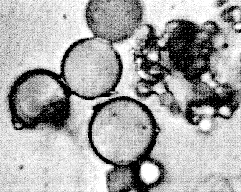
The first living systems probably resided in a molecular garden of Eden, where all the building blocks that contemporary organisms must work hard at synthesizing were available free. Under such conditions the numbers of organisms must have increased very rapidly. But such increases cannot go on indefinitely. In time the supply of some molecular building block must have become short. Those primitive organisms that had the ability to synthesize the scarce building block, say A, from a more abundant one, say B, clearly had a competitive advantage over those organisms that could not perform such a synthesis. In time, however, the secondary source of supply, B, would have also become depleted and those organisms that could produce it from a third building block, C, would have preferentially replicated. A U.S. biochemist, N.H. Horowitz, proposed that in this way the enzymatic reaction chains of contemporary organisms--each step catalyzed by a particular enzyme--originally evolved.
Even the evolution of enzymatic reaction chains may have occurred in free nucleic acids before the origin of the cell. The cell may have arisen in response to the need for maintaining a high concentration of scarce building blocks or enzymes, or as protection against the gradually increasing abundance of oxygen on the primitive Earth. Oxygen is a well-known poison to many biological processes, and in contemporary higher organisms the mitochondria that handle molecular oxygen are kept in the cytoplasm, far from contact with the nuclear material. Even today processes are known whereby polyamino acids form small spherical objects, microns to tens of microns across, with some of the properties of cells. These objects, called proteinoid microspheres, are certainly not cells, but they may indicate processes by which the ancestors of cells arose.

As the competition for building blocks increased among early life forms, and also perhaps as the abiological production of organic molecules dwindled because of the increasing oxygen abundance, the strictly heterotrophic way of life became more and more costly. The utilization of porphyrins, which are also made abiologically, by primitive photoautotrophs would have had great selective advantage. Many of the intermediates and enzymes in photosynthesis and in the anaerobic breakdown of carbon compounds are similar, but there is no generally accepted view of the origin of the photosynthetic process. Photosynthesis in procaryotes is more primitive than in such eucaryotes as green plants. In bacteria, water is not the ultimate source of hydrogen atoms for reducing carbon dioxide, and therefore oxygen is not produced. In addition, when a chlorophyll-containing cell is exposed both to light and to oxygen, it is killed unless it also contains an accessory carotenoid pigment. Thus green-plant photosynthesis had to wait until the appearance of carotenoids while bacterial photosynthesis, which does not produce oxygen, could function without carotenoids.
Excerpt from the Encyclopedia Britannica without permission.